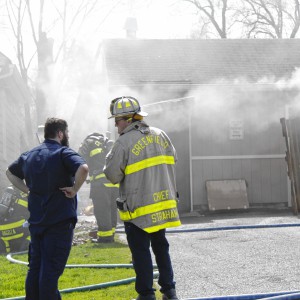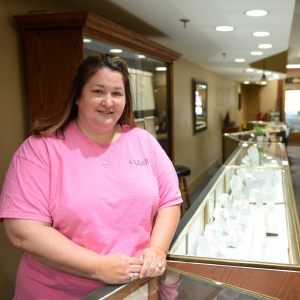Speaking of Nature: Puffballs are common, abundant and edible
| Published: 12-04-2016 11:41 PM |
As is the case every winter, the arrival of cold weather has me headed out to the woodpile on a regular basis. The weather has been generally warm this fall, but the Thanksgiving holiday brought family to visit, and some were not used to the cooler home that we wood stove enthusiasts have grown accustomed to. So, with the happiness and comfort of everyone on my mind, I diligently kept the stove stoked.
This allowed me to notice the sudden appearance of something interesting in the grass at the margins of the woodpile. Out of nowhere, it seemed to me, appeared puffballs. These are, in my humble opinion, rather beautiful members of the fungi kingdom that are widespread throughout the world. It is also the case that puffballs are widespread and easy to find in our area.
First, the name.
Puffballs are called “puffballs,” because of the way in which they spread their spores. As with all members of the fungi kingdom, puffballs produce microscopic haploid organisms packed into little capsules that are broadcast out into the world. These haploid organisms are different from you and me in the sense that they only have one copy of each chromosome, rather than the two copies you and I have.
So, where these spores have half the normal number — the “ha” in “haploid” — we have two copies, which makes us diploid organisms. In humans, the only haploid cells we produce are sperm and egg cells.
Your more traditional mushroom, with its cap and stalk, will produce spores under the cap and then sprinkle them out into the world. Puffballs, on the other hand, are more active broadcasters.
The puffball starts out as a firm, somewhat spherical object that might be reminiscent of a foam golf ball. The particular puffball species that I found is called a pear-shaped puffball (Lycoperdon pyriforme), and the origin of that name is obvious when you pick a young one and notice its definite pear shape.
The pear-shaped puffball starts out quite light in color, and its interior will be a solid white mass — imagine cutting a marshmallow in half. As the puffball matures, or ripens, the outside skin will darken in color and the center of the puffball with change from being solid and white to hollow and full of dust that I think resembles ground thyme. This powder is composed entirely of spores that are ready to be sent out into the world.
Article continues after...
Yesterday's Most Read Articles
 New owners look to build on Thomas Memorial Golf & Country Club’s strengths
New owners look to build on Thomas Memorial Golf & Country Club’s strengths
 Orange man gets 12 to 14 years for child rape
Orange man gets 12 to 14 years for child rape
 Greenfield Police Logs: April 2 to April 8, 2024
Greenfield Police Logs: April 2 to April 8, 2024
 One Greenfield home invasion defendant up for bail, other three held
One Greenfield home invasion defendant up for bail, other three held
 Fire scorches garage on Homestead Avenue in Greenfield
Fire scorches garage on Homestead Avenue in Greenfield
 Cleary Jewelers plans to retain shop at former Wilson’s building until 2029
Cleary Jewelers plans to retain shop at former Wilson’s building until 2029
When the puffball is finally ready, a small hole will appear in the center of its upper surface. At this point, the sides of the puffball will almost resemble paper, because they are dry and crinkly. All the puffball needs then is a little help from a passing animal, a falling acorn or even falling rain.
When the puffball is struck by an object, a “puff” of spores will shoot out. In some cases this can be quite dramatic and fun to see.
Pear-shaped puffballs generally emerge in the autumn. Technically, autumn continues until Dec. 21, so this is the time to look for them.
According to my trusty old “Peterson’s Field Guide to Mushrooms” (#34 for those in the know), pear-shaped puffballs can be found in, “clusters of medium-sized globose (spherical) or pear-shaped spore cases attached by conspicuous, string-like strands to decaying wood.”
Well, that couldn’t have been a more precise description of what I found! Note the dead piece of firewood the puffballs were growing next to. Also, note the conspicuous, string-like strand on the specimen that I picked. I happened to accidentally step on one of these puffballs and noted that the inside was, indeed, a solid white mass.
Now, I can’t conclude this column without making at least a small comment about the aesthetic sensibilities of my beautiful wife, Susan. During our Thanksgiving break, she noticed that I came in with a camera and asked if I had found anything interesting. When I showed her photos of the puffballs I noticed that her face scrunched up a bit, as though she had just bit into a slice of lemon.
That expression changed dramatically when I arrived at one particular photo. As sometimes happens, one of the puffballs I found had grown with an imperfection, making it look something more like an odd little peach. To Susan’s eyes, however, this was clearly a tushy. I may have even heard her liken it to a baby’s bottom. Trust me when I tell you, this was a wonderfully predictable reaction.
Suddenly, an icky mushroom became the object of great delight. That’s one of the many reasons I love Susan.
So, with most of us in the lower elevations still enjoying a lack of snow, and with prolonged period of rain providing puffballs and other mushrooms with the moisture they need to grow overnight, keep your eyes peeled.
The puffballs near my woodpile will mature in the next few days, and if I can get photos of them puffing out their spores, I will try to find a way to share them with you. Good luck in your efforts to find some of your own.
Bill Danielson has worked for the National Park Service, the US Forest Service, and the Massachusetts State Parks. He has been a professional writer and nature photographer for 19 years and he also teaches high school biology and physics. Visit www.speakingofnature.com for more information, or go to Speaking of Nature on Facebook.
]]>

 Speaking of Nature: Indulging in eye candy: Finally, after such a long wait, it’s beginning to look like spring is here
Speaking of Nature: Indulging in eye candy: Finally, after such a long wait, it’s beginning to look like spring is here Celebrating ‘Seasonings’: New book by veteran preacher and poet, Allen ‘Mick’ Comstock
Celebrating ‘Seasonings’: New book by veteran preacher and poet, Allen ‘Mick’ Comstock Faith Matters: How to still the muddy waters of overthinking: Clarity, peace and God can be found in the quiet spaces
Faith Matters: How to still the muddy waters of overthinking: Clarity, peace and God can be found in the quiet spaces A time for every purpose under heaven: Free sing-a-long Pete Seeger Fest returns to Ashfield, April 6
A time for every purpose under heaven: Free sing-a-long Pete Seeger Fest returns to Ashfield, April 6
